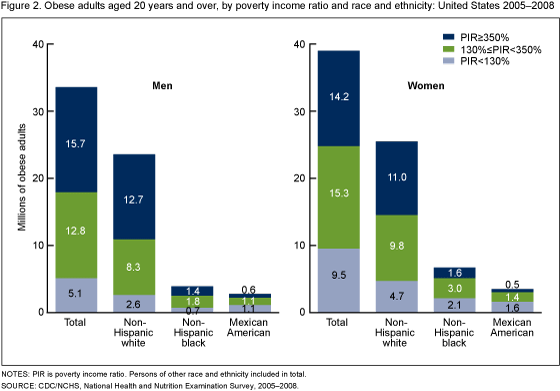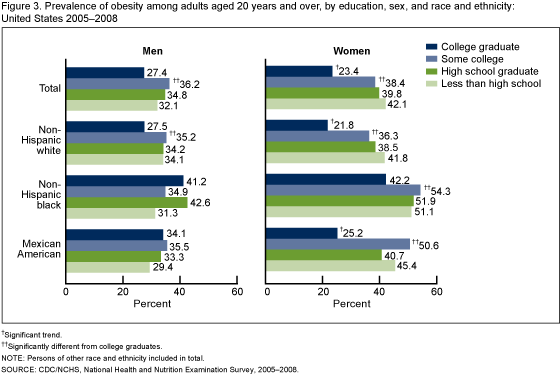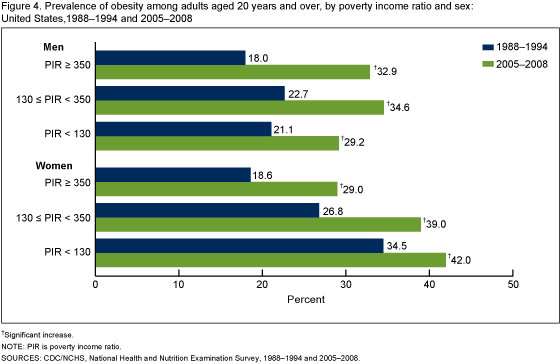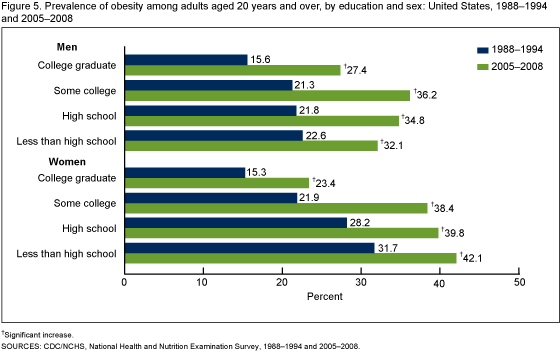Obesity and Socioeconomic Status in Adults: United States, 2005–2008
On This Page
- Key findings
- Data from the National Health and Nutrition Examination Survey, 2005–2008
- Among men, obesity prevalence is generally similar at all income levels, with a tendency to be slightly higher at higher income levels.
- Among women, obesity prevalence increases as income decreases.
- Most obese adults are not low income (below 130% of the poverty level).
- Among men, there is no significant trend between education level and obesity prevalence. Among women, obesity prevalence increases as education decreases.
- Between 1988–1994 and 2007–2008 the prevalence of obesity among adults increased at all income levels.
- Between 1988–1994 and 2007–2008 the prevalence of obesity among adults at all levels of education increased.
- Summary
- Definitions
- Data source and methods
- About the authors
- References
- Suggested citation
NCHS Data Brief No. 50, December 2010
PDF Version (1 MB)
Cynthia L. Ogden, Ph.D.; Molly M. Lamb, Ph.D.; Margaret D. Carroll, M.S.P.H.; and Katherine M. Flegal, Ph.D.
Key findings
Data from the National Health and Nutrition Examination Survey, 2005–2008
- Among men, obesity prevalence is generally similar at all income levels, however, among non-Hispanic black and Mexican-American men those with higher income are more likely to be obese than those with low income.
- Higher income women are less likely to be obese than low income women, but most obese women are not low income.
- There is no significant trend between obesity and education among men. Among women, however, there is a trend, those with college degrees are less likely to be obese compared with less educated women.
- Between 1988–1994 and 2007–2008 the prevalence of obesity increased in adults at all income and education levels.
In 2007–2008 more than one-third of United States adults were obese (1). Obese individuals are at increased risk of diabetes mellitus, cardiovascular disease, hypertension, and certain cancers, among other conditions (2). Some studies have shown a relationship between obesity prevalence and socioeconomic status measured as educational level or income (3,4). This data brief presents the most recent national data on obesity in United States adults and its association with poverty income ratio (PIR) and education level. Results are presented by sex and race and ethnicity.
Keywords: adults, obesity, income, education
Among men, obesity prevalence is generally similar at all income levels, with a tendency to be slightly higher at higher income levels.
Overall, almost 33% of men who live in households with income at or above 350% of the poverty level are obese, while 29.2% of men who live below 130% of the poverty level are obese (Figure 1). The relationship between obesity and income in men varies by race and ethnicity. Among non-Hispanic black and Mexican-American men, obesity prevalence decreases as income (PIR) decreases; 44.5% of non-Hispanic black men with income at or above 350% of the poverty level are obese compared with 28.5% of those with income below 130% of the poverty level. Similarly, among Mexican-American men, 40.8% of those with income at or above 350% of the poverty level are obese compared with 29.9% of those below 130% of the poverty level. There is no significant difference in obesity prevalence by poverty level among non-Hispanic white men.
Among women, obesity prevalence increases as income decreases.
Overall, 29.0% of women who live in households with income at or above 350% of the poverty level are obese and 42.0% of those with income below 130% of the poverty level are obese (Figure 1). Trends are similar for non-Hispanic white, non-Hispanic black, and Mexican-American women, but they are only significant for non-Hispanic white women. Among non-Hispanic white women with income at or above 350% of the poverty level 27.5% are obese, less than the 39.2% of those with income below 130% of the poverty level.
Most obese adults are not low income (below 130% of the poverty level).
Of the approximately 72 and a half million adults who are obese, 41% (about 30 million) have incomes at or above 350% of the poverty level, 39% (over 28 million) have incomes between 130% and 350% of the poverty level, and 20% (almost 15 million) have incomes below 130% of the poverty level. Among both men and women, most of the obese adults are non-Hispanic white with income at or above 130% of the poverty level. Approximately 21 million non-Hispanic white men and almost 21 million non-Hispanic white women who have incomes at or above 130% of the poverty level are obese (Figure 2).
Among men, there is no significant trend between education level and obesity prevalence. Among women, obesity prevalence increases as education decreases.
Among men, 27.4% of those with a college degree are obese compared with 32.1% of those with less than a high school education, although the difference is not statistically significant. Among women, 23.4% of those with a college degree are obese, significantly less than the 42.1% of women with less than a high school education. There is a threshold effect in both men and women, where the prevalence of obesity is significantly lower among those with college degrees compared with those with some college.
There are no significant differences in obesity prevalence by education level among non-Hispanic black and Mexican-American men. Among non-Hispanic white men there is a threshold effect, the prevalence is lower among college graduates compared with those with some college. Among women, non-Hispanic white and Mexican-American women with college degrees are significantly less likely to be obese compared with those with less than a high school education. In fact, among non-Hispanic white, non-Hispanic black, and Mexican-American women, the prevalence of obesity among those with a college degree is significantly lower than among women with some college (Figure 3).
Between 1988–1994 and 2007–2008 the prevalence of obesity among adults increased at all income levels.
In 1988–1994 the prevalence of obesity among men with income at or above 350% of the poverty level was 18.0%; in 2005–2008 the prevalence of obesity had increased in this group to 32.9%. The corresponding figures for those with income below 130% of the poverty level were 21.1% and 29.2%.
Similar increases occurred among women. In 1988–1994 the obesity prevalence was 18.6% among those with income at or above 350% of the poverty level and in 2005–2008 the prevalence had increased to 29.0%. Among those with income below 130% of the poverty level, the prevalence of obesity increased from 34.5% to 42.0% (Figure 4).
Between 1988–1994 and 2007–2008 the prevalence of obesity among adults at all levels of education increased.
Among men with a college degree, the prevalence of obesity increased from 15.6% to 27.4% between 1988–1994 and 2005–2008. Among those with less than a high school diploma, the prevalence increased from 22.6% to 32.1%. Similar increases were seen among men with some college or a high school diploma.
Among women, the prevalence increased from 15.3% to 23.4% in college graduates and from 31.7% to 42.1% in those with less than a high school diploma. As in men, similar increases were seen among women with a high school diploma and among those with some college (Figure 5).
Summary
The relationship between obesity and socioeconomic status differs by sex and race and ethnicity group. Among women, and specifically non-Hispanic white women, obesity prevalence increases as income (PIR) decreases, while among non-Hispanic black and Mexican-American men obesity prevalence decreases as income (PIR) decreases. Although the prevalence of obesity among women with income below 130% of the poverty level is higher than among those with higher incomes, most obese women do not have incomes below 130% of the poverty level. Among men and women with a college degree, the prevalence of obesity is lower than among those with some college education. Moreover, college educated women are less likely to be obese compared with those with less than a high school diploma. Between 1988–1994 and 2005–2008 the prevalence of obesity increased in adults at all levels of income and education.
Definitions
Obesity: Body mass index (BMI)≥ 30. BMI is calculated as weight in kilograms divided by height in meters squared, rounded to one decimal place. Examples of obesity cut points at specific heights are shown in the Table.
Table. Obesity cut points for adults 5’4” and 5’9”
| Height | Obese weight range |
|---|---|
| 5’4″ | 174 pounds or more |
| 5’4” | 79 kilograms or more |
| 5’9” | 203 pounds or more |
| 5’9” | 92 kilograms or more |
Poverty income ratio (PIR): The ratio of household income to the poverty threshold after accounting for inflation and family size. In 2008, a PIR of 350% was equivalent to approximately $77,000 for a family of four; a PIR of 130% was equivalent to approximately $29,000 for a family of four. In 2008, median household income was approximately $50,000 and 13.2% of the population lived below the poverty level . The cut point for participation in the Supplemental Nutrition Assistance Program (SNAP) is 130% of the poverty level.
Data source and methods
The National Health and Nutrition Examination Survey (NHANES) data were used for these analyses. NHANES is a cross-sectional survey designed to monitor the health and nutritional status of the civilian, noninstitutionalized U.S. population (5). The survey consists of interviews conducted in participants’ homes, standardized physical examinations that include measurement of weight and height conducted in mobile examination centers, and laboratory tests utilizing blood and urine specimens provided by participants during the physical examination.
The NHANES sample is selected through a complex, multistage design that includes selection of primary sampling units (counties), household segments within the counties, and finally sample persons from selected households. The sample design includes oversampling to obtain reliable estimates of health and nutritional measures for population subgroups. In 1988–1994 and 2005–2008, African-American and Mexican-American adults were oversampled. In 1999, NHANES became a continuous survey, fielded on an ongoing basis. Each year of data collection is based on a representative sample covering all ages of the civilian, noninstitutionalized population. Public-use data files are released in 2-year cycles.
Sample weights, which account for the differential probabilities of selection, nonresponse, and noncoverage, were incorporated into the estimation process. The standard errors of the percentages were estimated using Taylor Series Linearization, a method that incorporates the sample weights and sample design.
Estimates of the number of obese individuals were calculated using the average Current Population Survey (CPS) totals for 2005–2006 and 2007–2008.
Prevalence estimates for the total population were age adjusted to the 2000 U.S. standard population using three age groups, 20–39, 40–59, and aged 60 and over. Differences between groups were evaluated using a univariate t-statistic at the p < 0.05 significance level. Tests of trends were done using the p < 0.05 significance level. All differences reported are statistically significant unless otherwise indicated. Statistical analyses were conducted using the SAS System for Windows (release 9.1; SAS Institute Inc, Cary, N.C.) and SUDAAN (release 9.0; Research Triangle Institute, Research Triangle Park, N.C.).
About the authors
Cynthia L. Ogden, Molly M. Lamb, and Margaret D. Carroll are with the Centers for Disease Control and Prevention’s National Center for Health Statistics (NCHS), Division of Health and Nutrition Examination Surveys. Katherine M. Flegal is with NCHS’ Office of the Director.
References
- Flegal KM, Carroll MD, Ogden CL, Curtin LR. Prevalence and trends in obesity among United States adults, 1999–2008. JAMA 303:235–41. 2010.
- National Institutes of Health. Clinical Guidelines on the identification, evaluation, and treatment of overweight and obesity in adults-The evidence report. Obes Res 6 Suppl 2:51S–209S. 1998.
- Sobal J, Stunkard AJ. Socioeconomic status and obesity: A review of the literature. Psychol Bull 105:260–75. 1989.
- McLaren L. Socioeconomic status and obesity. Epidemiol Rev 29:29–48. 2007.
- Centers for Disease Control and Prevention. National Center for Health Statistics. National Health and Nutrition Examination Survey. Accessed November 18, 2010.
Suggested citation
Ogden CL, Lamb MM, Carroll MD, Flegal KM. Obesity and socioeconomic status in adults: United States 1988–1994 and 2005–2008. NCHS data brief no 50. Hyattsville, MD: National Center for Health Statistics. 2010.
Copyright information
All material appearing in this report is in the public domain and may be reproduced or copied without permission; citation as to source, however, is appreciated.
National Center for Health Statistics
Edward J. Sondik, Ph.D., Director
Jennifer H. Madans, Ph.D., Associate Director for Science
Division of Health and Nutrition Examination Surveys
Clifford L. Johnson, M.S.P.H., Director
- Page last reviewed: November 6, 2015
- Page last updated: December 14, 2010
- Content source:


 ShareCompartir
ShareCompartir




